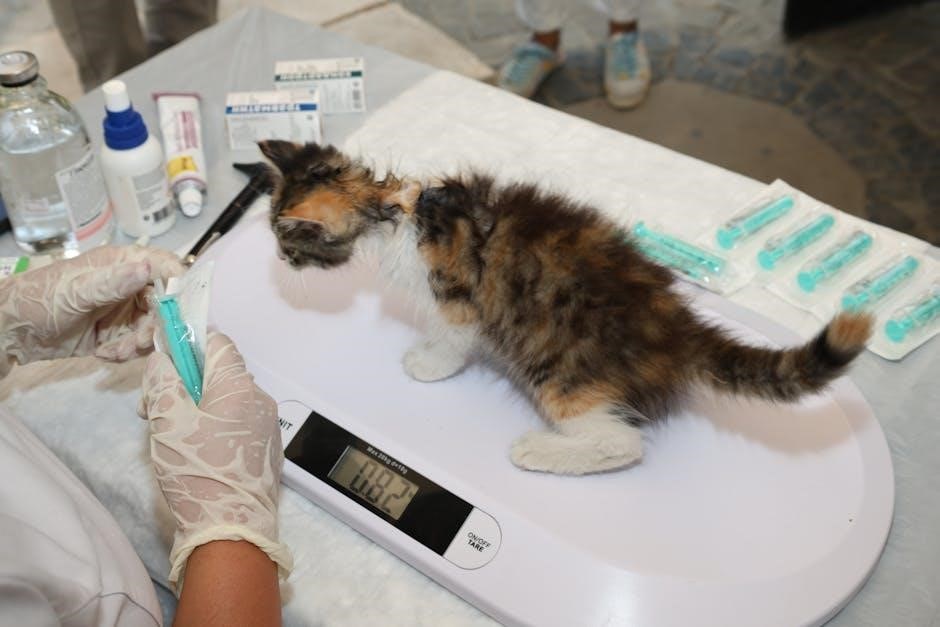The Brief Psychiatric Rating Scale (BPRS) is a widely used‚ standardized tool for assessing psychiatric symptoms․ It consists of 24 items evaluating anxiety‚ depression‚ and psychosis severity․ The BPRS is valued for its reliability and practicality in clinical and research settings‚ making it a key resource for mental health professionals․ Its availability in PDF format enhances accessibility for clinicians and researchers worldwide․
1․1 Overview of the BPRS
The Brief Psychiatric Rating Scale (BPRS) is a widely recognized tool for assessing psychiatric symptoms․ It includes 24 items that measure symptom severity on a 7-point scale‚ from “not present” to “extremely severe․” This structure allows clinicians and researchers to evaluate a broad range of symptoms systematically․
The BPRS is effective in both clinical practice and research‚ providing a standardized method to track symptom changes and treatment responses․ Its availability in PDF format enhances accessibility‚ making it a valuable resource for mental health professionals worldwide to assess and monitor psychiatric conditions effectively․
1․2 Importance of the BPRS in Psychiatry
The Brief Psychiatric Rating Scale (BPRS) is a cornerstone in psychiatric assessment‚ providing a standardized method to evaluate symptom severity․ Its ability to measure a wide range of symptoms‚ from anxiety to psychosis‚ makes it indispensable for clinicians and researchers․ The BPRS aids in diagnosing psychiatric conditions‚ monitoring treatment efficacy‚ and facilitating communication among healthcare providers․ Its widespread use ensures consistency in assessments‚ enabling comparisons across studies and clinical settings․ Additionally‚ the BPRS’s availability in PDF format enhances its accessibility‚ making it a practical tool for both routine clinical practice and large-scale research studies․
1․3 Brief History of the BPRS Development
The Brief Psychiatric Rating Scale (BPRS) was first developed in 1962 by Overall and Gorham to provide a standardized method for assessing psychiatric symptoms․ Initially designed for use in clinical trials‚ the scale gained popularity due to its simplicity and reliability․ Over the years‚ the BPRS has undergone revisions to enhance its validity and applicability across diverse psychiatric conditions․ Its widespread adoption in both clinical and research settings underscores its enduring utility․ The BPRS’s evolution reflects the growing need for standardized tools in psychiatry‚ making it a foundational instrument in the field․

Structure and Content of the BPRS
The BPRS includes 24 items assessing symptoms like anxiety and depression‚ rated 1-7․ Its structure ensures practicality for both clinical and research applications․
2․1 Number of Items and Rating Scale
The BPRS comprises 24 items‚ each evaluating specific psychiatric symptoms․ Ratings range from 1 to 7‚ where 1 indicates “not present” and 7 signifies “extremely severe․” This structured approach ensures clarity and consistency in symptom assessment‚ making it a reliable tool for clinicians and researchers․ The scale’s design allows for quick yet comprehensive evaluation‚ facilitating its use in various clinical settings․ Each item is clearly defined‚ ensuring raters can accurately assess symptom severity‚ thereby enhancing the tool’s overall effectiveness in monitoring patient progress and treatment outcomes․ The 7-point scale provides nuanced measurement‚ capturing subtle changes in symptomatology․
2․2 Symptoms Assessed by the BPRS
The BPRS evaluates a broad range of psychiatric symptoms‚ including anxiety‚ depression‚ guilt‚ and unusual thought content․ It also assesses positive symptoms like hallucinations and delusions‚ as well as negative symptoms such as blunted affect and emotional withdrawal․ The scale covers somatic concerns‚ disorganized thinking‚ and hostility‚ providing a comprehensive overview of a patient’s mental state․ Each symptom is rated based on its severity‚ allowing clinicians to monitor changes over time․ This wide coverage makes the BPRS effective for assessing diverse psychiatric conditions‚ ensuring a detailed and accurate evaluation of symptomatology across various diagnostic categories․
2․3 Scoring System and Interpretation
The BPRS uses a 7-point scoring system‚ with ratings ranging from 1 (“not present”) to 7 (“extremely severe”)․ Each symptom is assessed individually‚ and the total score reflects the overall severity of symptoms․ Higher scores indicate greater symptom severity․ The scale includes anchor points to guide accurate ratings‚ ensuring consistency across clinicians․ Interpretation involves evaluating the total score and individual symptom ratings to monitor changes over time․ This system allows for precise tracking of symptom progression and treatment response‚ making it a valuable tool for both clinical practice and research; The structured scoring system enhances reliability and facilitates comparative analyses․

Clinical Applications of the BPRS
The BPRS is widely used in clinical settings to assess psychiatric symptoms‚ monitor treatment progress‚ and aid in diagnosis․ Its simplicity and reliability make it a valuable tool for clinicians‚ enabling effective patient care and symptom tracking across various psychiatric conditions․ The scale’s versatility supports both routine clinical practice and specialized therapeutic interventions‚ ensuring comprehensive patient evaluation and management․ Its application spans diverse mental health disorders‚ reinforcing its role as a cornerstone in psychiatric assessment and treatment planning․ The BPRS’s clinical utility is further enhanced by its ability to track changes in symptom severity over time‚ aiding in personalized treatment strategies․
3․1 Use in Psychiatric Diagnoses
The BPRS is a valuable tool in psychiatric diagnoses‚ providing a structured assessment of symptoms such as anxiety‚ depression‚ guilt‚ and unusual thought content․ Clinicians use it to evaluate the presence and severity of psychiatric symptoms‚ aiding in differential diagnosis․ The scale’s 24 items‚ rated on a 1-7 severity scale‚ help identify key symptom domains relevant to various mental health conditions․ Its effectiveness in assessing both positive and negative symptoms makes it particularly useful for diagnosing schizophrenia and related psychotic disorders․ By standardizing symptom evaluation‚ the BPRS enhances diagnostic accuracy and informs personalized treatment plans‚ making it an essential resource in clinical practice․
3․2 Monitoring Treatment Efficacy
The BPRS is instrumental in monitoring treatment efficacy by tracking changes in psychiatric symptoms over time․ Clinicians administer the scale at baseline and follow-up to assess symptom improvement or deterioration․ Its 24-item structure allows for precise measurement of symptom severity‚ enabling healthcare providers to evaluate the effectiveness of pharmacological and psychotherapeutic interventions․ Regular use of the BPRS PDF helps in adjusting treatment plans based on objective data‚ ensuring personalized care․ This tool is particularly useful in longitudinal studies and clinical trials‚ where consistent monitoring of symptom dynamics is crucial for determining treatment outcomes and optimizing patient care strategies․
3․3 Comparison with Other Rating Scales (e․g․‚ PANSS)
The BPRS is often compared to the Positive and Negative Syndrome Scale (PANSS)‚ another widely used assessment tool․ While both scales measure psychiatric symptoms‚ the BPRS is more concise‚ focusing on 24 items compared to PANSS’s 30․ The BPRS is preferred for its brevity and ease of use‚ making it ideal for routine clinical practice․ PANSS‚ however‚ provides a more detailed assessment of negative symptoms․ Both tools are effective in evaluating treatment efficacy‚ but the BPRS is particularly advantageous for quick assessments and longitudinal monitoring․ Their similarities and differences make them complementary in both research and clinical settings for comprehensive patient evaluation․

BPRS in Research and Practice
The BPRS is a versatile tool widely used in both clinical research and daily practice․ Its structured format and reliability make it ideal for assessing symptom severity‚ monitoring treatment progress‚ and facilitating communication among healthcare providers․ Researchers appreciate its ability to track changes in psychiatric symptoms over time‚ while clinicians value its practicality for routine assessments․ The availability of the BPRS in PDF format further enhances its accessibility‚ ensuring consistent application across diverse settings․ This adaptability underscores its enduring relevance in modern mental health care and research․
4․1 Role in Clinical Trials
The BPRS plays a pivotal role in clinical trials by providing a standardized measure of psychiatric symptom severity․ Its structured format ensures reliability across diverse study populations‚ making it an essential tool for evaluating treatment efficacy․ Researchers utilize the BPRS to assess baseline symptoms and monitor changes over time‚ enabling accurate comparisons between intervention and control groups․ The scale’s ability to detect subtle symptom variations is particularly valuable in trials involving antipsychotic medications or psychotherapeutic interventions․ Furthermore‚ the availability of the BPRS in PDF format facilitates easy administration and data collection‚ streamlining the trial process and enhancing overall study efficiency․ Its widespread acceptance as a validated measure strengthens the credibility of clinical trial outcomes․
4․2 Use in Psychiatric Research Studies
The BPRS is extensively utilized in psychiatric research studies to assess symptom severity and track changes over time․ Its structured format allows researchers to evaluate a wide range of psychiatric symptoms‚ including anxiety‚ depression‚ and psychosis․ The scale’s reliability and validity make it a preferred tool for studying diverse populations‚ such as those with schizophrenia or mood disorders․ Researchers often use the BPRS to measure baseline symptoms and monitor longitudinal changes‚ enabling insights into treatment responses and disease progression․ The availability of the BPRS in PDF format further facilitates its use in large-scale studies‚ ensuring consistent data collection and analysis across research sites․
4․3 Practicality and Reliability in Clinical Settings
The BPRS is renowned for its practicality and reliability in clinical settings‚ making it a cornerstone in psychiatric practice․ Its concise structure allows clinicians to efficiently assess patients‚ ensuring timely and accurate evaluations․ The scale’s reliability across different raters minimizes variability‚ providing consistent results․ Clinicians appreciate the BPRS for its ease of administration and interpretation‚ which streamlines decision-making processes․ Furthermore‚ the availability of the BPRS in PDF format enhances its accessibility‚ enabling seamless integration into electronic health records․ This combination of practicality and reliability ensures that the BPRS remains a vital tool for mental health professionals in diverse clinical environments․

Accessing the BPRS in PDF Format
The Brief Psychiatric Rating Scale (BPRS) is easily accessible in PDF format‚ offering a convenient tool for clinicians and researchers to assess psychiatric symptoms effectively․
5․1 Sources for Downloading the BPRS PDF
The BPRS PDF is available through various academic and clinical resources․ Websites like ResearchGate and PubMed offer free downloads․ Additionally‚ the UCLA Clinical Research Center provides an expanded version․ Clinicians can also access it through professional psychiatric organizations or purchase it from medical publishers․ Ensure authenticity by sourcing from reputable platforms to maintain accuracy and reliability in clinical assessments․
5․2 Instructions for Completing the BPRS PDF
To complete the BPRS PDF‚ clinicians should first review the patient’s history and conduct a structured interview․ Each of the 24 symptoms is rated on a 7-point scale (1-7)‚ reflecting severity from “not present” to “extremely severe․” Clinicians must assess symptoms like anxiety‚ depression‚ and hallucinations‚ ensuring accurate and consistent ratings․ The manual provides anchor points for each score to guide evaluations․ After rating all items‚ calculate the total score to assess overall symptom severity․ Ensure all entries are clear and legible‚ and refer to the manual for clarification if needed․ Document the completion date and store the form securely․
5․3 Tips for Effective Use of the BPRS PDF
For effective use of the BPRS PDF‚ ensure proper training and familiarity with the scale’s structure and scoring system․ Conduct thorough patient interviews to gather accurate data․ Use the provided anchor points to guide consistent scoring․ Document all ratings clearly and legibly‚ avoiding ambiguities․ Regularly review and update the form to reflect changes in symptom severity․ Store completed PDFs securely to maintain patient confidentiality․ Consider integrating the BPRS with other assessment tools for a comprehensive evaluation․ Finally‚ refer to the manual or seek supervision if uncertainties arise during the assessment process․

Training and Certification for BPRS Usage
Proper training is essential for accurate BPRS administration․ Clinicians should participate in certified programs‚ such as those offered by UCLA‚ to master the scoring system and interpretation․
6․1 Importance of Proper Training
Proper training in using the BPRS is essential to ensure accurate and reliable assessments․ Clinicians must understand the scoring system‚ symptom definitions‚ and interview techniques to minimize errors․ Inadequate training can lead to inconsistent ratings‚ potentially affecting clinical decisions and research outcomes․ Training fosters a standardized approach‚ enabling professionals to interpret symptoms accurately and apply the scale effectively․ It also ensures inter-rater reliability‚ a critical factor in both clinical practice and research․ Without proper training‚ the utility of the BPRS diminishes‚ underscoring the need for comprehensive education to maximize its effectiveness in assessing psychiatric symptoms and improving patient care․
6․2 Available Training Programs
Several training programs are available to ensure clinicians master the BPRS․ These include workshops‚ online courses‚ and certification programs offered by academic institutions and professional organizations․ Many programs incorporate hands-on practice‚ case studies‚ and interactive sessions to enhance learning․ Some universities‚ like UCLA‚ provide comprehensive manuals and expanded versions of the BPRS for training purposes․ These resources often include interview schedules‚ symptom definitions‚ and anchor points to guide accurate ratings․ Additionally‚ webinars and seminars are increasingly popular for continuing education․ These programs aim to ensure that clinicians can reliably and effectively use the BPRS in both clinical and research settings․
6․3 Certification Process for Clinicians
Clinicians seeking certification in the BPRS must complete a structured training program‚ often provided by recognized institutions or professional organizations․ The process typically includes both theoretical and practical training‚ followed by a competency exam․ Certification ensures clinicians can administer and interpret the BPRS accurately‚ maintaining reliability and consistency․ Many programs require participants to demonstrate proficiency in rating symptoms and interpreting results․ Certification is highly recommended for professionals involved in clinical trials or research studies․ Periodic recertification may be necessary to stay updated on best practices and any scale updates‚ ensuring continued competence in using the BPRS effectively in clinical settings․

Case Studies and Examples
The BPRS is commonly applied in real-world clinical scenarios to assess symptom severity and track changes over time‚ providing valuable insights into treatment effectiveness and patient progress․
7․1 Application of BPRS in Real-World Scenarios
The BPRS is widely applied in clinical and research settings to evaluate psychiatric symptoms in diverse patient populations․ It is often used in clinical trials to assess treatment efficacy and monitor symptom changes over time․ Psychiatrists employ the BPRS to diagnose and manage conditions like schizophrenia‚ depression‚ and anxiety disorders․ The scale’s simplicity and reliability make it a valuable tool for routine psychiatric evaluations․ For instance‚ it helps clinicians track improvements or deteriorations in symptoms‚ guiding treatment adjustments․ Real-world examples include its use in hospitals‚ outpatient clinics‚ and research studies to ensure consistent and objective symptom assessment‚ enhancing patient care and outcomes․
7․2 Sample BPRS Assessments
Sample BPRS assessments provide practical examples of how the scale is applied in clinical practice․ For instance‚ a patient with anxiety may score 4 on the “Anxiety” item‚ indicating moderate severity․ Another patient with schizophrenia might receive a 6 on “Unusual Thought Content‚” reflecting severe symptoms․ These assessments guide clinicians in diagnosing and monitoring treatment responses․ The standardized scoring system ensures consistency‚ allowing for reliable comparisons across assessments․ Sample assessments also highlight how the BPRS captures a range of symptoms‚ from somatic concerns to guilt feelings‚ offering a comprehensive view of a patient’s mental health status․ This aids in personalized treatment planning and outcome evaluation․
7․3 Interpretation of BPRS Results in Clinical Context
Interpreting BPRS results involves understanding the severity of symptoms and their impact on the patient’s functioning․ Scores range from 1 to 7‚ with higher values indicating greater symptom severity․ For example‚ a score of 5 on “Depression” suggests moderate to severe symptoms‚ warranting targeted intervention․ Clinicians use these scores to monitor changes over time‚ assess treatment efficacy‚ and adjust therapeutic strategies․ Contextualizing results within the patient’s history and presentation ensures a holistic approach․ This interpretation guides clinical decision-making‚ fostering personalized care and improving patient outcomes․ Accurate interpretation is essential for effective management of psychiatric conditions and tracking progress in treatment settings․

Limitations and Critiques of the BPRS
The BPRS may exhibit scorer bias due to subjective interpretations․ Its cross-cultural applicability is challenged by varying symptom expressions and diagnostic criteria across different populations and regions․
8․1 Potential Biases in Scoring
The BPRS may be subject to scorer bias‚ as ratings depend on clinicians’ interpretations and experiences․ Cultural differences and varying symptom presentations can influence scores‚ potentially leading to inconsistent assessments across diverse populations․ Additionally‚ without standardized training‚ clinicians may interpret symptom severity differently‚ affecting reliability․ This underscores the importance of uniform training and clear anchor points to minimize subjective variability․ Addressing these biases ensures more accurate and reliable evaluations in both clinical and research settings․
8․2 Challenges in Cross-Cultural Applications
The BPRS faces challenges in cross-cultural settings due to variations in symptom expression and interpretation․ Cultural differences in understanding mental health can lead to inconsistent ratings‚ as certain symptoms may be perceived differently across cultures․ Language barriers and the scale’s primary development in Western contexts further complicate its application in non-Western populations․ Additionally‚ cultural biases among clinicians may influence scoring‚ potentially affecting the tool’s reliability․ These challenges highlight the need for cultural adaptation and validation of the BPRS to ensure accurate and equitable assessments across diverse populations‚ making it a more universally applicable tool in global mental health care․
8․3 Comparison of Limitations with Other Scales
The BPRS shares limitations with other rating scales‚ such as the PANSS‚ particularly in cross-cultural applications and potential scorer biases․ Unlike the PANSS‚ however‚ the BPRS is shorter and less detailed‚ which may limit its depth in assessing symptom complexities․ While the PANSS offers a broader evaluation of negative symptoms‚ the BPRS is more focused on general psychopathology․ Both scales face challenges in ensuring consistent scoring across different clinicians and cultural contexts․ Despite these shared limitations‚ the BPRS remains a practical tool for quick assessments‚ whereas the PANSS is often preferred for comprehensive evaluations in research settings․

Future Directions and Innovations
The BPRS may evolve through digitalization‚ enhancing accessibility and data collection․ Integration with other tools could improve comprehensive assessments․ Future updates may refine symptom measurement and scoring systems․
9․1 Digitalization of the BPRS
Digitalization of the BPRS is transforming its accessibility and utility․ Electronic versions enable faster data entry and analysis‚ reducing errors․ Mobile apps and online platforms facilitate real-time assessments‚ benefiting clinicians and researchers․ Digital tools also support data sharing and integration with electronic health records․ This shift enhances the scale’s practicality‚ ensuring it remains a vital tool in modern psychiatric practice․ Digitalization also opens opportunities for remote assessments‚ expanding its reach to diverse populations and settings․
9․2 Integration with Other Assessment Tools
The integration of the BPRS with other assessment tools enhances comprehensive psychiatric evaluations․ Combining it with scales like the PANSS or CGI provides a holistic view of symptom severity and treatment response․ Digital platforms facilitate seamless integration‚ allowing clinicians to compare and contrast data․ This approach ensures a more accurate diagnosis and personalized treatment plans․ Integration also supports multi-disciplinary collaboration‚ as different tools can complement each other․ By combining the BPRS with other assessments‚ mental health professionals can gain deeper insights into patient conditions‚ improving overall care quality and outcomes․
9․3 Potential Updates to the BPRS
Potential updates to the BPRS could include expanding its symptom criteria to address emerging psychiatric conditions and improving its cultural sensitivity for global use․ Enhancing the scale’s digital interface for easier administration and interpretation is another area of focus․ Additionally‚ incorporating more nuanced measures for assessing cognitive and affective symptoms could increase its diagnostic accuracy․ Developers may also consider updating anchor points and scoring guidelines to reflect contemporary clinical standards․ These updates aim to maintain the BPRS’s relevance and effectiveness in modern psychiatric practice while ensuring it remains a reliable tool for both research and clinical applications․
The BPRS remains a vital tool in psychiatry‚ offering reliable symptom assessment․ Its availability in PDF format ensures accessibility for clinicians and researchers‚ aiding in understanding and managing psychiatric symptoms effectively․
10․1 Summary of Key Points
The Brief Psychiatric Rating Scale (BPRS) is a 24-item tool assessing psychiatric symptoms like anxiety‚ depression‚ and psychosis․ Widely used in clinical and research settings‚ it provides reliable and practical symptom evaluation․ Its availability in PDF format enhances accessibility for professionals․ The BPRS is valued for its structured approach‚ enabling consistent assessments across diverse populations․ It serves as a cornerstone for monitoring treatment efficacy and understanding symptom dynamics․ The scale’s simplicity and effectiveness make it a preferred choice for clinicians and researchers‚ contributing significantly to psychiatric care and research advancements․
10․2 Final Thoughts on the BPRS
The Brief Psychiatric Rating Scale remains a cornerstone in psychiatric assessment‚ offering a reliable and practical tool for measuring a broad range of symptoms․ Its structured approach ensures consistency‚ making it invaluable in both clinical and research settings․ The BPRS’s availability in PDF format enhances accessibility‚ allowing professionals to easily integrate it into their workflows․ It plays a crucial role in monitoring treatment efficacy and understanding symptom dynamics‚ contributing significantly to advancements in psychiatric care․ As a preferred tool for its effectiveness‚ the BPRS continues to support better patient outcomes and informed clinical decision-making‚ solidifying its importance in modern psychiatry․
10․3 Recommendations for Future Use

The BPRS should continue to be enhanced through digitalization‚ improving accessibility and integration with electronic health records․ Future updates could incorporate new symptom dimensions and cultural adaptations to ensure global applicability․ Regular training programs and certification processes should be emphasized to maintain reliability․ Collaboration with other assessment tools‚ like the PANSS‚ could provide a more comprehensive evaluation․ Periodic revisions to reflect current psychiatric understanding and treatment advancements are essential․ By addressing these areas‚ the BPRS can remain a vital tool in psychiatry‚ supporting better patient outcomes and informed clinical decision-making․
